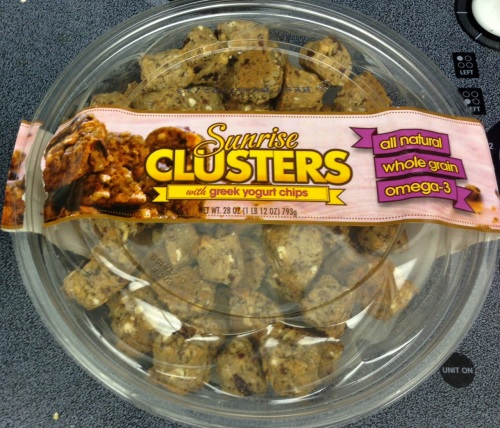Another trip through Costco, another fun healthy snack food found. I wrote about Sunrise Energy Bars back in November and recounted how much I enjoyed them as an energy boost on bike rides.
Apparently now comes the next chapter from the Sunrise brand. These are not bars, but just about bite size (slightly bigger) clusters of a granola-like substance. The package boasts ALL NATURAL, WHOLE GRAIN, OMEGA 3. As you can see from the photo, they come in a big tub and are not individually wrapped like a lot of energy products.

For folks with little impulse control, here is my early verdict. I have snacked on a couple of them and liked the taste very much. They are very handy for a guy like me who tosses little snacks into a bag and brings them on bike rides for energy pick me ups.
The ingredients include: whole grain rolled oats, whole grain oat flour, cranberries, raisins, dried apples, apricots, almonds, sesame seeds, flax seeds, chia seeds, hemp seeds, sunflower seeds, cashews, walnuts, shredded coconut, non-hydrogenated canola oil, unsalted butter, Greek yogurt chips, sugar, palm kernel oil, yogurt powder, whey protein concentrate, nonfat dry milk, yogurt cultures, reduced mineral whey powder, lactic acid, soy lecithin, vanilla, brown sugar, honey, salt, baking powder, baking soda, tapioca syrup, natural flavor and cinnamon.
The nutritional breakdown is as follows:
Serving size 3 pieces (28 grams) which amounts to one ounce.
Calories 140
Total fat 8 grams
Saturated fat 2 grams
Cholesterol 5 mg
Sodium 75 mg
Total carbohydrates 15 grams
Fiber 2 grams
Protein 3 grams
Nutritionally, the Clusters are almost identical with the Sunrise Energy Bars:
Here is the nutritional breakdown for a single Sunrise Energy Bar of 28 grams:
Calories 130
Total fat 6 grams
Saturated fat 3 grams
Cholesterol 10 mg
Sodium 75 mg
Total carbohydrates 17 grams
Fiber 3 grams
Protein 2 grams
They don’t taste very different, either. So, it may come down to what shape you like your energy snacks in, bite-sized cluster, or slightly larger snack bar.
As far as function goes, I ride my bike almost daily here in Chicago. I take along snacks to boost my energy. When I take a break for a snack I try to limit my intake to about 50 calories so my body doesn’t get hung up in digestion. So, the slightly lower in calorie Clusters appeal to me.
As always, your comments are welcome.
Tony
Wellness Secrets of a SuperAger























